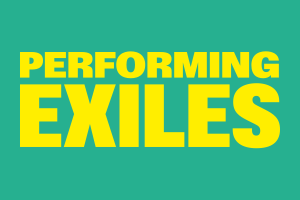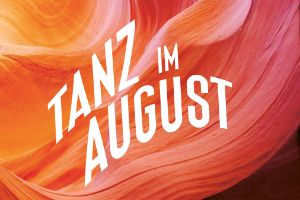
Exhibition
Omer Fast
»Talking is not always the solution«

Exhibition poster “Omer Fast»Talking is not always the solution«”. Image: Omer Fast: August, 2016. single screen, 3D projection Courtesy Galerie Arratia Beer / gb agency / Dvir Gallery / James Cohan Gallery / Filmgalerie 451 © Omer Fast. Poster design Ta-Trung
“I am interested in creating my own little world and losing myself in it.”
Omer Fast
Omer Fast (* 1972) is one of the most distinctive film and video artists of his generation. He creates narrations in his films that question the borders between one’s own and media narratives and between current and historic events. His works address the friction between documentary and fiction. The Martin-Gropius-Bau showed seven of his projects at his first large solo exhibition in Berlin.
Works shown were: CNN Concatenated from 2002, Looking Pretty for God (after G.W.) from 2008, 5000 Feet is the Best from 2011, Continuity from 2012, Everything That Rises Must Converge from 2013, Spring from 2016, as well as a new work called August from 2016. Shot in 3D, August is based on the life and work of renowned Cologne photographer August Sander (1876-1964). In surreal dream sequences, the artist is haunted at the end of life by the death of his son and the figures he photographed.
In his cinematic works, Fast tells stories of trauma, war and relationships. Our impulse to identify with the people whose stories we witness is often undermined by conflicting accounts, inexplicable changes or outright lies. Everything that we know and believe could be entirely different. Omer Fast’s films are more than thought experiments or games between narration and enactment. They are simultaneously oppressive and moving.
In addition to presenting projection-based works in customary dark spaces, the artist also created three new installations resembling waiting rooms: a doctor’s clinic, an airport lounge and an immigration office. These waiting rooms featured older monitor-based works and were also sites for performances planned for the exhibition.
This exhibition at the Martin-Gropius-Bau was held as part of the program “Immersion. Analogue Arts in the Digital Age”. “Immersion” was a program of the Berliner Festspiele scheduled for three years. It regularly displayed works of art which one does not face from the opposite side, but enters to become part of them – as a performance or sculpture, choreography, narrative space or virtual reality experience.
His works in the Martin-Gropius-Bau:
CNN Concatenated 2002 (18-minutes, single screen, looped)
In CNN Concatenated, Omer Fast splices a vast amount of CNN footage: Male and female presenters, reporters and weathermen briefly flash across the screen, their sentences are fragmented to such a degree that each person only ever gets to say one word before disappearing. Edited from a database of ten-thousand clips, the words are strung together to form hurried and jerky sentences, which address the viewer directly and in very personal terms. Started in late 2000 and taking two years to complete, the work is a time capsule that shows the transformation of news coverage before, during and after September 11, 2001, while hijacking that coverage to deliver a monologue about fear and longing.
Looking Pretty for God (After G.W.) 2008 (28-minutes, single screen, looped)
Looking Pretty for God is a straight-forward documentary, in which North-American funeral directors speak about their work. As the professionals responsible for a deceased person’s last public appearance, funeral directors’ line of work falls somewhere between make-up artistry, plastic surgery, grief counseling, event planning, and magic. While the camera explores the largely empty funeral homes in which these men work, little children sometimes appear and explain what we’re seeing.
5000 Feet is the Best 2011 (30-minutes, single screen, looped)
Originally premiered in the 52nd Venice Biennale, 5000 Feet is the Best is based on conversations with a U.S. Predator drone operator, which were recorded in a hotel in Las Vegas. On-camera, the drone operator discussed the technical aspects of his job and his daily routine. Off-camera and off-the-record, he briefly described incidents in which the unmanned plane fired at both militants and civilians. The film fluidly moves from documentary to reenactment and fiction, weaving together the drone operator’s account along with scenes depicting crimes in and around Las Vegas.
Continuity 2012 (40-minutes, single screen, looped)
Commissioned for Documenta 13, Continuity follows a young German soldier returning home after serving in Afghanistan. A familiar domestic environment with emotional parents soon gives way to a series of anomalies that gradually become perverse and uncanny. It remains unclear whether the couple has suffered an actual loss or if they’re performing an obsessive ritual that keeps them together. A total of three different sons spend the night at the house. Each disappears under mysterious circumstances.
Everything That Rises Must Converge 2013 (4-Channel Video, 56 minutes, looped)
Everything That Rises Must Converge is a four-channel digital film that depicts a working day in Los Angeles, weaving together documentary material and fictional scenes involving several characters. The documentary component follows four adult-film performers on their everyday life, starting at home as they get out of bed and going through their entire day until they go back home and get into bed at night. All along the way, we encounter fictional characters who appear on the set of the Porn shoot: A director who turns trauma into art, a husband and wife in the middle of a crisis and an actress who is questioning her role.
Spring 2016 (44-minutes, five-screen projection, looped)
Presented on five interconnected screens, Spring is a portrait of two young German men whose lives intersect violently. A teenaged boy finds a way to earn extra cash by visiting a middle-aged couple and performing as their son. An older male escort is also hired by the couple, but disappears after visiting the local bakery. Moving backwards and forwards in time, the work shows characters who are lost and trying to connect, before reaching a surprising end from two different perspectives. Spring is a companion piece to the artist’s earlier film, Continuity, (2012) which is also shown in the exhibition.
August 2016
Shot in 3D, the new project is loosely based on the life and work of the Cologne photographer August Sander (1876-1964). In surreal and dreamy sequences, the short film imagines the artist at the end of his life, nearly blind and haunted by the death of his son and by the figures he has photographed.
In addition to the film projections in ordinary darkened rooms, the artist will design three exhibition rooms as waiting rooms. Omer Fast himself spent a lot of time in waiting rooms which have therefore often expanded, and even replaced, his studio: The waiting hall at the airport, the waiting room at the doctor and that of the Aliens Registration Office. Conceptualized as a waiting area for exhausted exhibition visitors, as alternatively bright rooms to display some of the artist's earlier works and as a place where performances and interventions for the exhibition are planned, the three waiting rooms will be an integral part of »Talking is not always the solution«.

